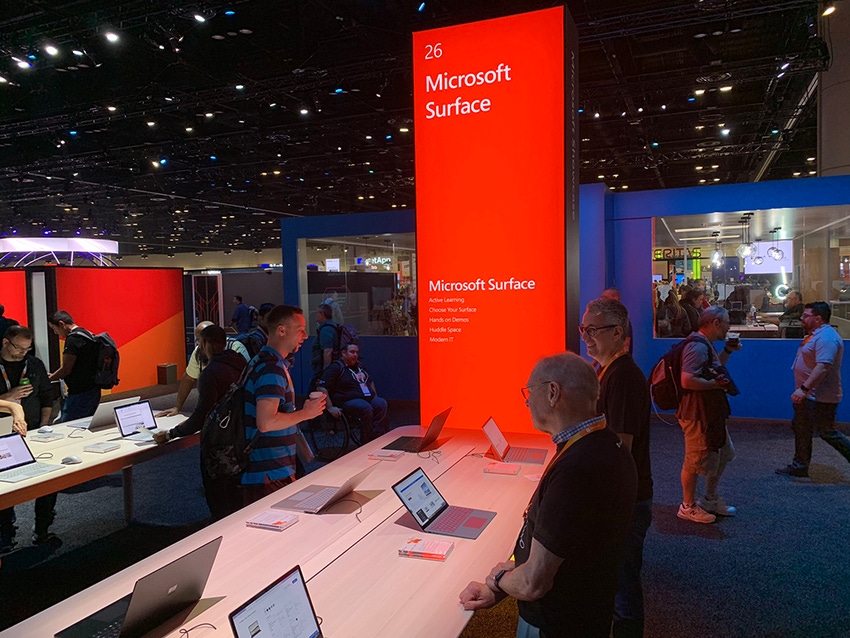First ARM-based Surface Pro, co-developed with Qualcomm, debuted for Microsoft Ignite attendees.
November 7, 2019

(Pictured above: Microsoft Ignite attendees get a hands-on introduction to the new Surface Pro X.)
Microsoft is putting its expanded portfolio of Surface PCs in the spotlight at this week’s annual Microsoft Ignite conference in Orlando, Florida, where 30,000 attendees are seeing the new ARM-powered Surface Pro X for the first time.
While the Surface Pro 7 and Surface Laptop 3 started shipping last month sporting incremental improvements over their predecessors, the new ARM-powered Surface Pro X started shipping yesterday. It is the first major redesign of Microsoft’s 2-in-1 tablet PCs since 2014, which started shipping this week.
The Surface Pro X is the first PC powered by Microsoft’s new SQ1 processor. Co-developed with Qualcomm, Microsoft said the LTE-based Surface Pro X is the fastest processor created to date by Qualcomm for a PC. The new tablet-PC is also considerably thinner than its predecessors, measuring just 5.33mm, and lighter, weighing 1.68 lbs. and sporting thinner bezels.

Microsoft’s Robin Seiler
Because the Surface Pro X is powered by the new SQ1 processor, it’s not designed to run 64-bit applications. Configured with an optimized version of Windows 10, it can run 32-bit applications, such as Office. “It’s designed for modern workers who want to be productive and always connected,” said Robin Seiler, Microsoft’s corporate vice president for devices during a group interview at Ignite.
Consequently, Seiler said, channel partners can help commercial and enterprise customers understand what type of employees are suited to benefit using the new Surface Pro X. “When we look at who uses Surface Pros today, we know that Pro X can handle their workloads,” Seiler said. “But at the same time, because it doesn’t run 64-bit apps today, if you want to run triple-a games, you can’t and if you want to run CAD, it’s not the right device for you. And so that’s the conversation the channel and our sales force must have with customers to make sure they end up with the right device.”
The introduction of an ARM-based processor to the Surface Pro X breaks new ground, Seiler added, in that the SQ1 processor runs at 7 watts and can burst up to 15 watts. Typical ARM processors, originally designed for smartphones, run at 2-3 watts, she said.
“What that means is you get laptop level performance,” Seiler said. “And you use laptop memory, not phone memory. All of that matters in terms of total performance for the device. In addition, we integrated AI and ML capability into the processor. And what that means is we offload those workloads into a separate part of the processor, so it doesn’t burn the processor.”

Moor Insights’ Patrick Moorhead
Industry analysts furnished with test units last week said it’s difficult to distinguish the difference in performance running Office and web apps with the Surface Pro X. “It’s surprisingly robust,” said Patrick Moorhead, founder and chief analyst at Moor Insights and Technology. “I wouldn’t run [Adobe] Photoshop on it but it runs Office apps like any other Surface Pro, except it’s thinner and a bit lighter.
The Surface Pro X requires a different keyboard than its predecessors, which has a slot…
… to store the new Microsoft electronic pen. Also new in the Surface Pro X and the other new devices launched last month is support for a removable SSD, for those with compliance needs. Unlike previous models, it is also designed to enable repairs.
Seiler said Microsoft has a Surface Partner Council that provides input into how the company’s devices flow through the channel. The council consists of 60 partners spanning collaboration solution providers, resellers and distributors. Following Microsoft’s Oct. 2 Surface launch event in New York, the company invited the partner advisory council to Redmond, where they spent several days learning about the Surface Pro X, Surface Pro 7 and Surface Laptop 3.

Microsoft’s Matt Barlow
“We typically do a lab tour and have lots of discussions,” said Matt Barlow, Microsoft’s corporate vice president for modern life, search and devices. “And we discuss what’s coming and get feedback from them.”
Read more about:
MSPsAbout the Author(s)
You May Also Like


